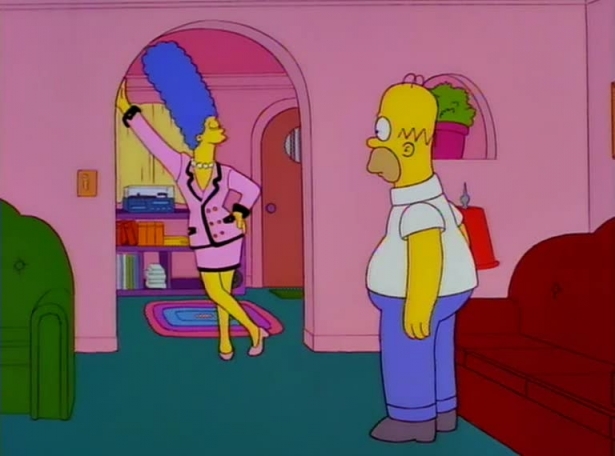For a show about yellow-skinned middle Americans with four fingers and no chins who never appear to change their outfits, The Simpsons has a surprisingly fruitful relationship with fashion. From Marc Jacobs’ tattoo, to Jeremy Scott’s fall/winter 2012 collection, and the animated family’s Harper’s Bazaar’s appearance they’ve long been unlikely, although beloved, sartorial subjects. The feeling is mutual; the show’s creators often weave fashion into storylines, calling on clothes and aesthetics to offer redemption, motivation, and occasionally, temptation. Even if that Paris Fashion Week episode grossly overestimated the appeal of capri cargo pants.
With this month marking 30 years since the family first debuted on The Tracey Ullman Show, we’re celebrating by looking back at how The Simpsons has demonstrated the power of fashion.
That mangled Chanel suit in Scenes From the Class Struggle in Springfield
You can’t talk about fashion and The Simpsons without mentioning Marge’s brief affair with Chanel. Yes she found her famous pink suit in a clearance store — easily the bargain of the century — but it soon demonstrated how a strong look can change your life. After being spotted pumping gas in the ensemble by an old school friend, Marge is invited into the exclusive world of Springfield’s country club.
She does a pretty good job of remaking the original outfit each week to appear like a new garment, but when a sewing accident ruins everything she panics and spends all their savings on a new (full-priced) Chanel gown. Eventually she realizes how myopic she has been, and that fashion has created a divide between her and the rest of the family. She takes back the new dress and returns to her regular life. We’re not sure if it’s what we personally would have done, but she learned something about being herself.
Non-colorfast uniforms in Team Homer
This episode from season seven saw Bart accidentally give his school cause to introduce a uniform after his “Down With Homework” t-shirt sparks a riot. That in itself is an argument in the ongoing debate over the actionable power of slogan tees — see also the Marge t-shirt in The Last Temptation of Homer — but it’s the transformation of the students when they’re unable to express themselves through clothes which really anchors the episode. Despite all wearing the same outfits everyday, being forced into drab grey uniforms saps the student body of any joy. They only recover when a passing rainstorm causes the fabric dye to run, reminding them of how happy color can make them.
The dangers of counterfeit jeans in The Springfield Connection
When Marge decides to serve her town and become a cop in season six, she ends up uncovering a counterfeit jeans ring operating out of her own garage during Homer’s weekly poker nights. Straight away, the fake fashion drives a divide between the couple. But later, when the criminals try and escape by using the pants to zip-line away, the shoddy workmanship sees them rip and the criminals fall into police clutches. Endemic corruption means the counterfeiters eventually get away, but the episode’s ultimate message is clear — don’t waste your money on fakes.
The sweat cleaning suit in Colonel Homer
When Homer starts managing country music ingénue Lurleen Lumpkin, his relationship with Marge is tested. As Lurleen falls in love with him, she buys him a fancy white suit as a show of appreciation. The outfit, which is in stark contrast to his usual style, is symbolic of the distance growing between him and his wife and the damaging presence of Lurleen in their marriage. Eventually he discards the suit, and the songstress, and returns home to Marge.
The power of a turtleneck in The Last Temptation of Krust
When Krusty embarks on a career renaissance, he chooses to disregard his old wardrobe and makeup in preference for something considerably simpler. Dressed in the uniform of a more modern generation of comedians, he remakes himself and his act, camouflaging in with his new community. Not only does his look demonstrate how clothes can allow us to infiltrate different social worlds, but the aesthetic transformation fuels his creative one and gives him additional confidence. Ultimately, though, the change doesn’t stick, he can’t alter who he really is — a money-obsessed lush — no matter how hard he rocks a sport-coat and jeans combo.
That pink shirt in Stark Raving Dad
Perhaps the most devastating example of how our outfit choices can change our lives can be found in the third season episode, Stark Raving Dad. While the guest appearance of Michael Jackson is what dominates most of the episode, the catalyst to the story is Homer’s institutionalization. The serious action comes about because he wore a pink shirt to work, after Bart’s lucky read cap turned a load of white washing a pretty shade of what would become known as millennial pink. It’s strange now to think in a world of combined runways and Gucci boys endlessly rocking pussy bow blouses that a pink business shirt was such an offense, but it does mark how far we’ve come with color choices.
The true cost of fur in Two Dozen and One Greyhounds
When Mr. Burns set out to steal Santa’s Little Helper’s puppies to make a suit, he wasn’t only providing a catchy song and dance number, but also introducing a generation to the devastating impact of the fur trade. Yes, the episode was fun — arguably one of the show’s most-loved — but it was also a pretty brutal look at how we often disregard the rights of animals for fashion.
Credits
Text Wendy Syfret
